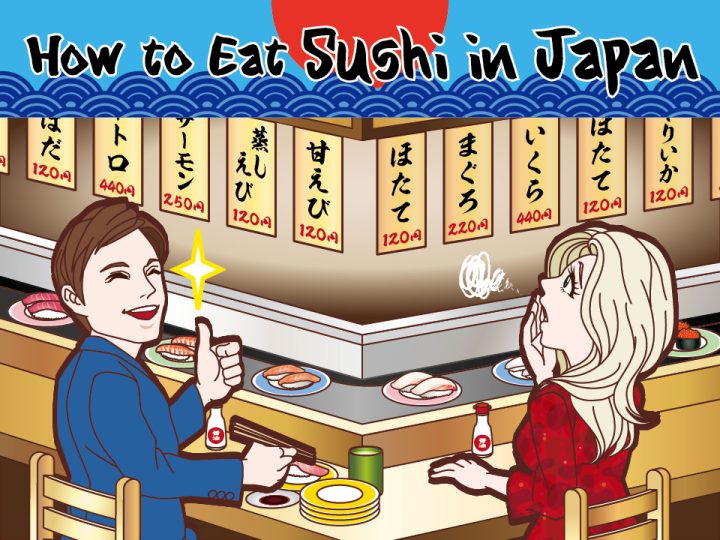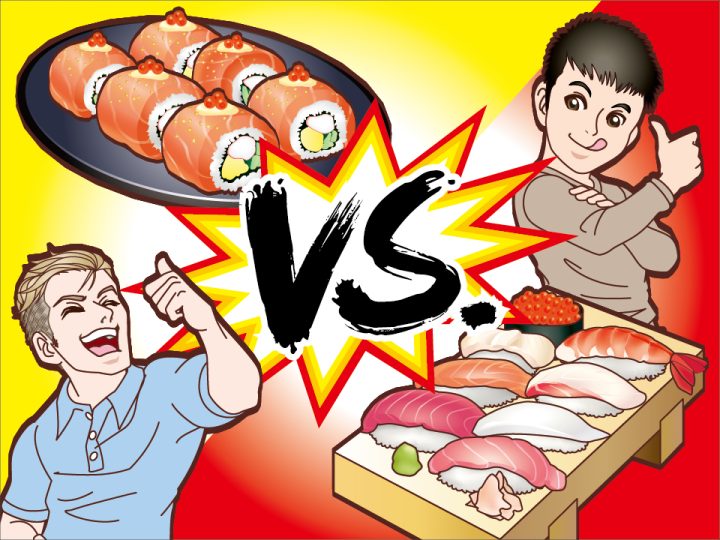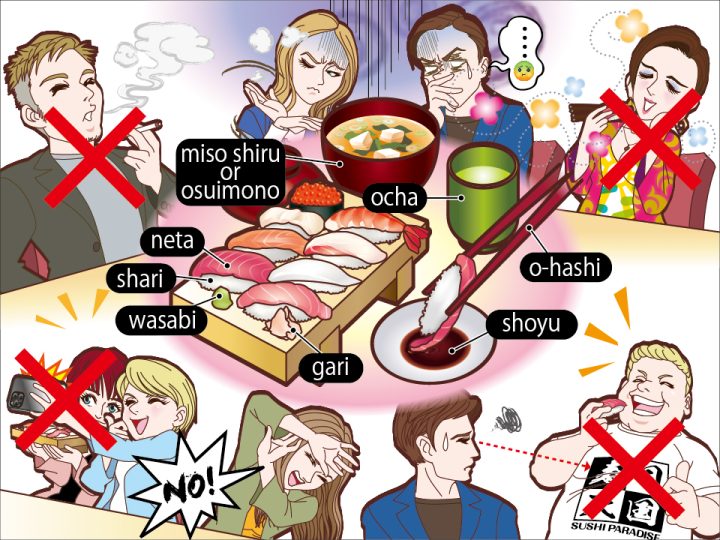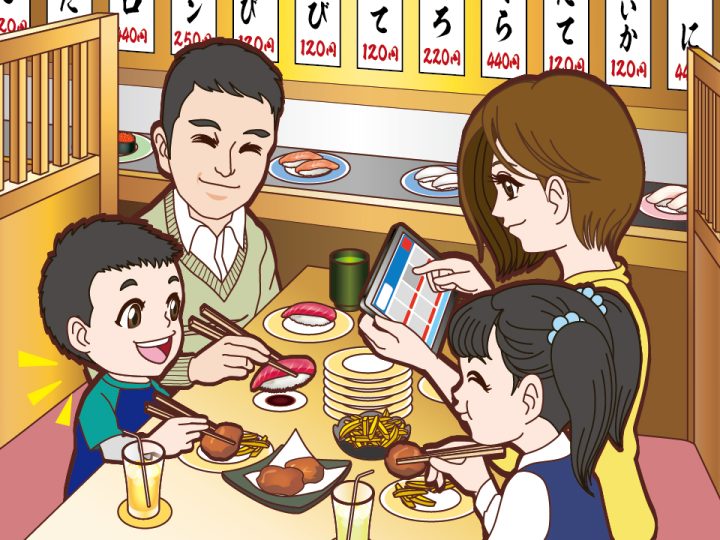- LEARN
- how-to manga
- HOW TO EAT SUSHI IN JAPAN

HOW TO EAT SUSHI IN JAPAN

Enjoying Authentic Japanese Sushi
In Japan, the focus of most sushi establishments is nigiri sushi, featuring expertly prepared sushi rice, or shari served with delicately pressed fish on top. While sushi rolls, or maki-sushi, do exist in Japan, they differ significantly from the elaborate colorful creations found in a California or Dragon roll invented outside of Japan. Japanese sushi chefs prioritize simplicity, emphasizing freshness and a delicate balance of flavor. The provided tips aim to alleviate any apprehension regarding potential mistakes or faux pas, ensuring a pleasant dining experience at a sushi restaurant in Japan.
In Japan, the focus of most sushi establishments is nigiri sushi, featuring expertly prepared sushi rice, or shari served with delicately pressed fish on top. While sushi rolls, or maki-sushi, do exist in Japan, they differ significantly from the elaborate colorful creations found in a California or Dragon roll invented outside of Japan. Japanese sushi chefs prioritize simplicity, emphasizing freshness and a delicate balance of flavor. The provided tips aim to alleviate any apprehension regarding potential mistakes or faux pas, ensuring a pleasant dining experience at a sushi restaurant in Japan.

Essential Etiquette for Sushi Dining in Japan
When eating sushi, everything has a specific purpose. Pickled ginger, or gari, serves as a palate cleanser between sushi tastings, highlighting the subtlety of each flavor. Warm green tea is served to clear any lingering taste. Moderate use of shoyu (soy sauce) and wasabi should be observed to avoid overshadowing the taste of the sushi itself. Each piece is intended to be eaten in one bite, but you can ask for smaller pieces if necessary. There is no prescribed order for eating, but it is best to save sweeter dishes for last to preserve your palate. Also, the technically correct way to dip nigiri sushi in soy sauce is dipping the fish side and not the rice side.
In general, consideration for those around you is important. Of course, smoking and loud behavior are discouraged, but less obvious considerations would be excessive perfume, photography, or too casual dress. Remember many places operate on a cash-only basis so prepare accordingly.
When eating sushi, everything has a specific purpose. Pickled ginger, or gari, serves as a palate cleanser between sushi tastings, highlighting the subtlety of each flavor. Warm green tea is served to clear any lingering taste. Moderate use of shoyu (soy sauce) and wasabi should be observed to avoid overshadowing the taste of the sushi itself. Each piece is intended to be eaten in one bite, but you can ask for smaller pieces if necessary. There is no prescribed order for eating, but it is best to save sweeter dishes for last to preserve your palate. Also, the technically correct way to dip nigiri sushi in soy sauce is dipping the fish side and not the rice side.
In general, consideration for those around you is important. Of course, smoking and loud behavior are discouraged, but less obvious considerations would be excessive perfume, photography, or too casual dress. Remember many places operate on a cash-only basis so prepare accordingly.

Counter-style Sushi
Traditional counter-style sushi establishments offer a subdued and authentic experience. Typically, patrons sit at a counter where sushi is presented directly by the chefs. Ordering differs by location but many restaurants offer three options: omakase, meaning chef’s choice, okonomi, customer’s choice, and okimari, a set menu. Each has benefits, but omakase puts you in the hands of the chef and provides the freshest in-season options. Communicating any budget or dietary concerns beforehand is common. To choose your own sushi, some restaurants offer okonomi, but remember to vary your orders to accommodate limited availability. Also remember to be mindful of not adding too much soy sauce or wasabi. Usually, wasabi is already included between the “shari” rice and fish topping “neta”, so if you do not like wasabi you should request to the chef, “wasabi-nuki” or simply “sabi-nuki”.
Traditional counter-style sushi establishments offer a subdued and authentic experience. Typically, patrons sit at a counter where sushi is presented directly by the chefs. Ordering differs by location but many restaurants offer three options: omakase, meaning chef’s choice, okonomi, customer’s choice, and okimari, a set menu. Each has benefits, but omakase puts you in the hands of the chef and provides the freshest in-season options. Communicating any budget or dietary concerns beforehand is common. To choose your own sushi, some restaurants offer okonomi, but remember to vary your orders to accommodate limited availability. Also remember to be mindful of not adding too much soy sauce or wasabi. Usually, wasabi is already included between the “shari” rice and fish topping “neta”, so if you do not like wasabi you should request to the chef, “wasabi-nuki” or simply “sabi-nuki”.

Revolving Style Kaitenzushi
Conveyor-belt sushi, or kaitenzushi provides a unique and very popular dining experience. Especially Japan's many chain locations provide a convenient, family-friendly way to enjoy sushi. The atmosphere is quite different from the traditional counter-style sushi. Customers face a conveyor belt that delivers various sushi and other options. While affordable, the freshness and artistry associated with traditional sushi may be compromised. It’s essential to remember you should not touch unwanted sushi on the conveyor belt. Also be aware that sometimes you will find a special ring around a plate or a separate belt lane that are specifically for customer orders, so those are not free for the taking. Different colored plates represent different prices. Many chains offer self-serve water and condiments and some tables have hot water dispensers and powdered green tea. Be careful not to burn yourself and add only a spoonful or two of the tea. Most utilize touchscreens for ordering that can easily be switched to English so you should have no trouble navigating your kaitenzushi experience.
*Please note that many kaitenzushi restaurants are currently order-only after the COVID-19 pandemic, though certain places still use the conveyor belt system.
Conveyor-belt sushi, or kaitenzushi provides a unique and very popular dining experience. Especially Japan's many chain locations provide a convenient, family-friendly way to enjoy sushi. The atmosphere is quite different from the traditional counter-style sushi. Customers face a conveyor belt that delivers various sushi and other options. While affordable, the freshness and artistry associated with traditional sushi may be compromised. It’s essential to remember you should not touch unwanted sushi on the conveyor belt. Also be aware that sometimes you will find a special ring around a plate or a separate belt lane that are specifically for customer orders, so those are not free for the taking. Different colored plates represent different prices. Many chains offer self-serve water and condiments and some tables have hot water dispensers and powdered green tea. Be careful not to burn yourself and add only a spoonful or two of the tea. Most utilize touchscreens for ordering that can easily be switched to English so you should have no trouble navigating your kaitenzushi experience.
*Please note that many kaitenzushi restaurants are currently order-only after the COVID-19 pandemic, though certain places still use the conveyor belt system.

Traditional Edo-style or Edomae Sushi
There are many different kinds of sushi and different varieties are popular in different regions around Japan. Edo-style at a more expensive, traditional style sushi restaurant is the kind of sushi where each piece is made by hand at the counter right in front of where you sit. It is considered to be a fully finished piece when it is given to you and should be consumed without adding anything else to it including shoyu or wasabi. For example, when ordering a nigiri course at Tokinari Sushi in Koenji, Chef Sato skillfully prepares each handmade piece of nigiri-sushi from the freshest fish in season he obtains from Toyosu fish market that morning, and places it in front of you as soon as it is ready to eat. This style of sushi can also be eaten by picking it up with your fingers, though chopsticks can be considered optional. Each piece is intended to be eaten as soon as it is given to you.
There are many different kinds of sushi and different varieties are popular in different regions around Japan. Edo-style at a more expensive, traditional style sushi restaurant is the kind of sushi where each piece is made by hand at the counter right in front of where you sit. It is considered to be a fully finished piece when it is given to you and should be consumed without adding anything else to it including shoyu or wasabi. For example, when ordering a nigiri course at Tokinari Sushi in Koenji, Chef Sato skillfully prepares each handmade piece of nigiri-sushi from the freshest fish in season he obtains from Toyosu fish market that morning, and places it in front of you as soon as it is ready to eat. This style of sushi can also be eaten by picking it up with your fingers, though chopsticks can be considered optional. Each piece is intended to be eaten as soon as it is given to you.
Conclusion
Sushi has become a worldwide culinary phenomenon and has come to include a great variety of different kinds of food that may or may not be considered sushi in Japan. Fusion and international interpretations of sushi can be amazing and innovative, but eating sushi in Japan is an altogether different experience. Visiting a sushi restaurant in Japan can be a little overwhelming at times so this guide should help you to fully enjoy an authentic Japanese sushi dining experience.
Related Content:
[published March 2024]
Assistance: Tokinari Sushi
Illustration: Takeshi Kamimaru
Text/Research: Joel Graybill








